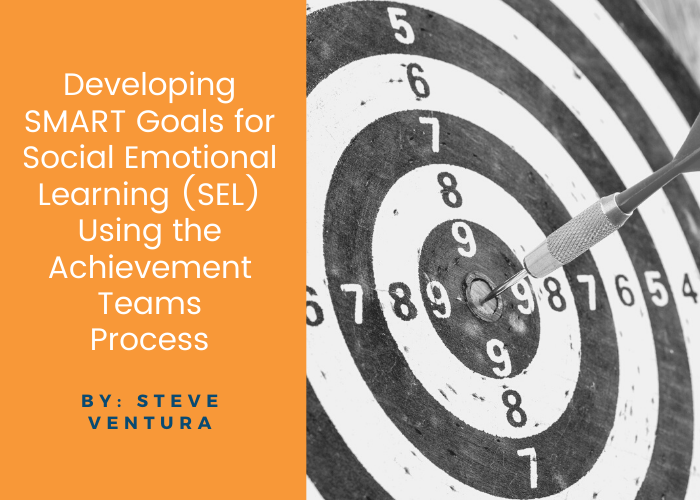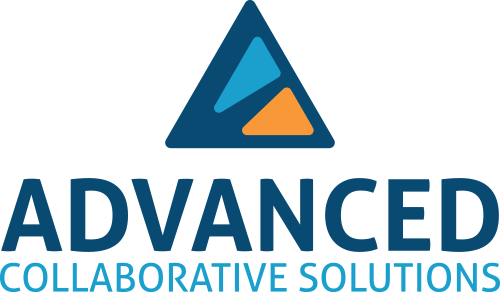Developing SMART Goals for Social Emotional Learning (SEL) Using the Achievement Teams Process

By: Steve Ventura
It’s no surprise that Social Emotional Learning (SEL) has become an increased focus for schools, families, and the entire education community, specifically over this last year. Students have struggled with an onset of emotional and social needs with school buildings closed and a pandemic wreaking havoc on many families in a variety of ways. It has become increasingly clear that SEL is no longer something that is a “nice to have” or that can be left to the school counselor, but something that is a critical priority for all classroom teachers and school leaders. SEL allows educators to focus on the whole child by addressing social, emotional, character, and mindset initiatives when it comes to growth and learning in order to make a meaningful difference in school and classroom climate while having a positive impact on the lives of students beyond just academics.
One consistent strategy of effective SEL programs is to encourage the use of reasonable goal setting so students can achieve a specific, self-regulated, behavioral target. These goals can consist of effort management, personal goals, and academic goals. But how is one to go about setting goals when it comes to SEL?
While many educators, including myself, historically think of goal setting in terms of academic outcomes, the ideas around setting SEL-focused goals follow a process that has worked for many educators. For example, our team has developed a collaborative protocol known as Achievement Teams, which is an experiential, collaborative, four-step protocol that focuses on student growth through the lens of collective teacher efficacy. All of the components of Achievement Teams intentionally align with those teacher and leadership profiles that have the most significant impact on student achievement. This framework provides a structure for teachers to accurately reflect on teaching between pre- and post-assessments while identifying areas of student need, which are not limited solely to academic needs.
Goal setting is such a critical part of the Achievement Teams process that our forthcoming book has an entire chapter dedicated to the process since goals can significantly accelerate student learning. For example, as children transition through elementary school, there is an increased need for a focus on planning, organizing, and goal-setting. SEL goals can also help focus attention to the development of empathy, social awareness, and perspective-taking as children develop an increased capacity for understanding the needs and feelings of others. And as students matriculate up to middle and high school, goals become even more relevant, particularly in the areas of academics, social life, and long-term plans.
SMART Goals—Academic Growth and SEL
Achievement Teams replicate the same sense of motivation when harnessing instructional efforts towards a common goal, and as a result, teachers' sense of efficacy increases. In 1981, George T. Doran published an article in the November issue of Management Review. He formulated the SMART goal framework by including five key factors. SMART goals should be: Specific, Measurable, Achievable, Relevant, and Timely. By using SMART goals, based on learning standards, teachers guide their instruction and assessment to truly know the impact of their teaching. SMART goals are learner goals because a goal is something we have identified as a means to improving outcomes.
But the idea is to model the process when it comes to SEL goals, which can be challenging for a number of reasons. SEL growth can be more difficult to measure and SEL standards don’t exist in every state. In 2018, The Collaborative for Academic, Social, and Emotional Learning (CASEL) found that 18 states have SEL standards or competencies, a number that continues to grow each year.
Let’s take a look at a “traditional,” academic SMART goal within an Achievement Team.
Assume that your seventh-grade language arts team has administered a pre-assessment and organized the results. It is now time to set a goal between the pre- and post-assessment.
Example Goal: The percentage of students scoring in “achieving” and higher in LITERACY: RI. 7.2 will increase from 34% to 72% as measured by a team-created, formative, short-cycle assessment administered on April 29, 2020.
SPECIFIC: We are focusing on learning intention RI.7.2.
MEASURABLE: We will calculate pre- and post-assessment results.
ACHIEVABLE: Our goals are set at an appropriate level of challenge.
RELEVANT: Students struggle with this learning intention. If mastered, it can help students enter the next grade level with a confidence and readiness to learn.
TIMELY: We have set a date to determine progress (April 29, 2020).
But what does this look like for an SEL goal? Let’s dig deeper.
Consider what you want to measure in terms of SEL. Maybe you want to focus on how students have positive interactions with one another and learn strategies to solve problems with other students. Or maybe you want to have students increase self-awareness of their emotions, recognizing peers or even characters in stories exhibiting similar emotions. Or maybe you want to address awareness around bullying behaviors within your school or classroom.
Example Goal: By the end of November, 100% of students will be able to define and identify bullying behaviors within the school and classroom.
SPECIFIC: We are focusing on school bullying.
MEASURABLE: We will ensure 100% of students can identify bullying behaviors as measured in a post assessment. This can be a writing assignment, a digital poll, a role-playing exercise, etc.
ACHIEVABLE: Our goals are set at an appropriate level of challenge.
RELEVANT: Students must first define bullying behavior to be able to address it in later grades and to develop empathy around the topic.
TIMELY: We have set a date to determine progress (end of month).
The process of writing SMART goals and assessing their progress works best when completed within a PLC or Achievement Team. When teachers can collaborate to plan instruction and focus on the needs of their students, both academic and SEL-related, teachers develop a community where they are all working towards the greater good.
Personal Goal Setting for Students
Teaching students to set personal goals must include an appropriate level of challenge while helping students identify their own gaps in learning. According to the Visible Learning research, goal setting for students is maximized when teachers provide strategies to show students how to write goals. (Hattie, 2011) To accomplish this, teachers can conduct one-to-one goal-setting conferences with students so they can help students not only set their goals, but to create goals that represent the correct level of difficulty. There are a multitude of strategies for goal setting. Goals that include specific performance scores or targets are more likely to motivate students than general goals, like “do your best.” As with teacher-created SMART goals, the process of student goal setting should also include character or SEL-focused goals to show students that character education is equally important to academic outcomes.
Goals must also be age-appropriate, with consideration taken between elementary, middle, and high school students. Contrary to what some may believe, even our younger students can be taught how to create and understand a learning goal and celebrate growth, whether the goal has been achieved or not. The most critical factor in student goal setting is for teachers to be explicit in their goal setting instructions. Goal setting is not an inherent skill for many students.
Creating goals for both students and teachers has a tremendous impact on academic outcomes. Goals lead to better student self-assessment, self-evaluation, and self-monitoring of progress. When students and teachers regularly create and include challenging goals, students are more motivated to exert effort in line with the difficulty of a task. (Hattie, 2009)
References
Collaborative for Academic, Social, and Emotional Learning. (2018). State Scan. Chicago, IL: https://casel.org/state-scan-scorecard-project-2/.
Doran, G. T. (1981). "There's a S.M.A.R.T. Way to Write Management's Goals and Objectives", Management Review, Vol. 70, Issue 11, pp. 35-36.
Hattie, John. (2009). Visible Learning: A synthesis of over 800 meta-analyses relating to achievement. New York, NY: Routledge.
Hattie, John. (2011). Visible Learning for Teachers: Maximising Impact on Learning. London: Routledge.

